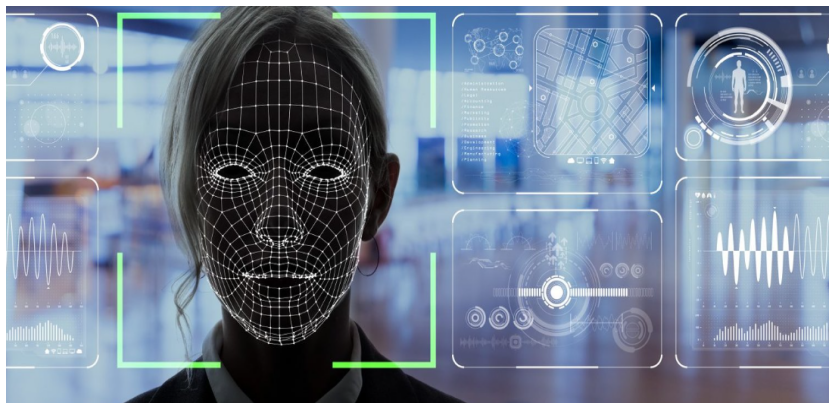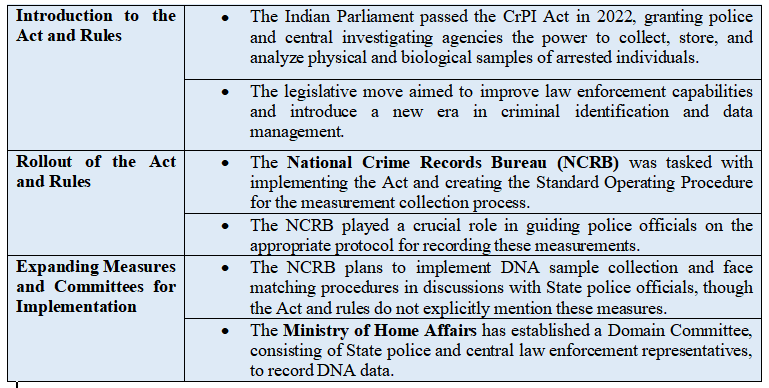- Courses
- GS Full Course 1 Year
- GS Full Course 2 Year
- GS Full Course 3 Year
- GS Full Course Till Selection
- MEP (Mains Enrichment Programme) Data, Facts
- Essay Target – 150+ Marks
- Online Program
- GS Recorded Course
- NCERT- First Ladder
- Polity
- Geography
- Economy
- Ancient, Medieval and Art & Culture AMAC
- Modern India, Post Independence & World History
- Environment
- Governance
- Science & Technology
- International Relations and Internal Security
- Disaster Management
- Ethics
- Current Affairs
- Indian Society and Social Issue
- CSAT
- 5 LAYERED ARJUNA Mentorship
- Public Administration Optional
- ABOUT US
- OUR TOPPERS
- TEST SERIES
- FREE STUDY MATERIAL
- VIDEOS
- CONTACT US
DNA and Face Matching Systems At Police Stations
DNA and Face Matching Systems At Police Stations
26-10-2023

Why in News?
Recently, Over a year after Parliament passed the Criminal Procedure Identification Act (CrPI), 2022; Central Government has decided to introduce 'DNA and Face Matching' systems in 1,300 police stations nationwide, despite the Act's provisions not yet being fully implemented.
About ‘DNA and Face Matching Systems’ Under CrPI Act, 2022

About DNA and Face Matching Systems’ Technology
-
DNA Matching Systems:
- DNA matching systems, also known as DNA profiling or DNA fingerprinting, are methods used to compare and identify individuals based on their distinctive genetic traits.
- These systems analyze specific DNA regions, which are highly variable among individuals, to create a unique genetic profile for each individual.
- DNA matching is a crucial tool in criminal investigations, linking suspects to crime scenes or victims by comparing DNA profiles of potential suspects.
-
Face Matching System:
- The Face Matching System is an algorithm-based technology that creates a digital map of an individual's face by identifying and mapping their facial features.
- Automated Facial Recognition System (AFRS) utilizes a vast database of photos and videos of individuals to match and identify them.
- CCTV footage of an unidentified person is analyzed using Artificial Intelligence technology for pattern-finding and matching, comparing it to the existing database.

Advantages DNA and Face Matching Systems’ Technology and Changes in Act:
- Improved Investigative Tools: Law enforcement now employs DNA and face-matching techniques for identifying suspects and solving crimes, providing a more efficient alternative to traditional methods like fingerprinting.

- Enhanced Data Integration: The Act's integration with National Automated Fingerprint Identification System (NAFIS) enhances a centralized database of criminal and suspect information, enhancing law enforcement's understanding of illegal activities and expediting investigations.
- Greater Range of Identification Techniques: The Act expands identification beyond footprints, photos, and fingerprints by examining biological and physical samples like retina and iris scans, enabling identification of charged and uncharged individuals.
- National-Level Repository: Home Ministry has established a central organization to ensure data accessibility and uniformity, facilitating inter-agency and inter-state investigations.
- Modernization of Law Enforcement: The Act enhances law enforcement's ability to identify individuals involved in illegal activities through advanced biometric technology, including facial and DNA matching.
Challenges for implementation
- Lack of proper data: The absence of adequate data security legislation can lead to data breaches, which can then be exploited for terrorism and other unlawful activities.
- Unequal distribution of infrastructure: India's infrastructure disparity hinders widespread technology adoption due to inadequate internet penetration in remote areas, limiting access to technology provided by law enforcement.
- Budget constraints: Many police stations nationwide face financial challenges due to budget constraints, making the deployment of new equipment impractical.
- Lack of tools: Many agencies lack the necessary mobile or software tools to improve interagency collaboration or maintain community officers.
- Inadequate training: Indian law enforcement authorities face a significant technological gap due to inadequate training and access to advanced technology.
Way Forward
-
Robust Safeguards against Misuse
- The NCRB emphasizes the need for technological, legal, and security measures to prevent database misuse, requiring authorized access and advanced, legally compliant tools and technology.
-
Ensuring Data Security
- Robust protocols for data usage, storage, and security, including real-time access for designated officials and strong encryption, are crucial for gaining confidence in personal data protection.
-
Balancing Privacy and Law Enforcement
- India must balance law enforcement power with protecting citizens' civil liberties and privacy, requiring adequate oversight to prevent excessive encroachment on individual freedoms during system implementation.
Conclusion
The Act and technology have significantly modernized India's criminal justice and law enforcement systems, enhancing the collection and utilization of biometric data for investigations. The Act, approved by Parliament, faces challenges like connection and logistical issues that hinder its full implementation.



